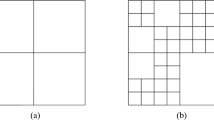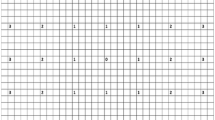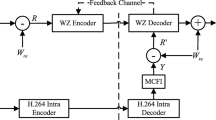Abstract
In the inter-frame coding, the SKIP mode with the application of few signaling bits is a highly-efficient prediction method. Specifically, it can skip over the encoding process of motion vectors, residuals and other syntax elements. Moreover, the motion information of adjacent blocks is adopted to predict the motion parameters of the skipped blocks according to the spatial correlations. In the state-of-art designs, the SKIP mode is generally used for a square prediction block, thus leaving broad space for further investigations. Since the nonsquare prediction mode has been proved to be an effective tool, this paper proposes to employ the SKIP mode for the nonsquare prediction mode. We believe that the nonsquare SKIP mode can further save the signaling bits, because all-zero residuals will occur in the nonsquare blocks. Considering that the nonsquare prediction blocks probably contain directional features, a nonsquare transform is proposed hereafter. The test model of the latest High Efficiency Video Coding (HEVC) standard is applied in this research to examine the performance of the proposed method, and the test results show that the coding performance has been improved.








Similar content being viewed by others
References
Sullivan, G. J., Ohm, J.-R., Han, W.-J., & Wiegand, T. (2012). Overview of the High Efficiency Video Coding (HEVC) standard. IEEE Transactions on Circuits and Systems for Video Technology, 22(12), 1649–1668.
Ohm, J.-R., Sullivan, G. J., Schwarz, H., Tan, T. K., & Wiegand, T. (2012). Comparison of the coding efficiency of video coding standards—including High Efficiency Video Coding (HEVC). IEEE Transactions on Circuits and Systems for Video Technology, 22(12), 1669–1684.
Lainemam, J., Bossen, F., Han, W.-J., Min, J., & Ugur, K. (2012). Intra coding of the HEVC standard. IEEE Transactions on Circuits and Systems for Video Technology, 22(12), 1707–1719.
Helle, P., Oudin, S., Bross, B., Marpe, D., Bici, M. O., Ugur, K., Jung, J., Clare, G., & Wiegand, T. (2012). Block merging for quadtree-based partitioning in HEVC. IEEE Transactions on Circuits and Systems for Video Technology, 22(12), 1707–1719.
Ugur, K., Alshin, A., Alshina, E., Bossen, F., Han, W.-J., Park, J.-H., & Lainema, J. (2013). Motion compensated prediction and interpolation filter design in H.265/HEVC. IEEE Journal of Selected Topics in Signal Processing, 7(6).
Kim, I.-K., Min, J., Lee, T., Han, W.-J., & Park, J.-H. (2012). Block partitioning structure in the HEVC standard. IEEE Transactions on Circuits and Systems for Video Technology, 22(12), 1697–1706.
Joint Call for Proposals on Video Compression Technology, ITU-T SG16 Q6 document VCEG-AM91 and ISO/IEC JTC1/SC29/WG11 document N11113, ITU-T SG16 Q6 and ISO/IEC JTC1/SC29/WG11, Kyoto, Japan, Jan. 2010.
Lin, J.-L., Chen, Y.-W., Huang, Y.-W., & Lei, S.-M. (2013). Motion vector coding in the HEVC standard. IEEE Journal of Selected Topics in Signal Processing, 7(6).
Bross, B., Han, W.-J., Sullivan, G. J., Ohm J.-R., & Wiegand, T. (2012). High Efficiency Video Coding (HEVC) text specification draft 8, ITU-T/ISO/IEC Joint Collaborative Team on Video Coding (JCT-VC) document JCTVC-J1003.
Yu, A., & Lee, R. (1997). Early detection of all-zero coefficients in H.263. IEEE Conference On Picture Coding Symposium (PCS) (pp. 159–164). Berlin, Germany.
Moon, Y.-H., Kim, G.-Y., & Kim, J.-H. (2005). An improved early detection algorithm for all-zero blocks in H.264 video encoding. IEEE Transactions on Circuits and Systems for Video Technology, 15(8), 1053–1057.
Glantz, A., Tok, M., Krutz A., & Sikora, T. (2011). A block-adaptive skip mode for inter prediction based on parametric motion models. IEEE International Conference on Image Processing (ICIP) (pp. 1201–1204).
Bossen, F. (2012).Common HM test conditions and software reference configurations. ITU-T/ISO/IEC Joint Collaborative Team on Video Coding (JCT-VC) document JCTVC-K1100.
Wiegand, T., Sullivan, G. J., Bjøntegaard, G., & Luthra, A. (2003). Overview of the H.264/AVC video coding standard. IEEE Transactions on Circuits and Systems for Video Technology, 13(7), 560–576.
Sullivan, G. J., & Weigand, T. (1998). Rate-distortion optimization for video compression. IEEE Processing Magazine, 15(6), 74–90.
Yuan, Y., Kim, I.-K., Zheng, X., Liu, L., Cao, X., Lee, S., Cheon, M.-S., Lee, T., He, Y., & Park, J.-H. (2012). Quadtree based nonsquare block structure for inter frame coding in High Efficiency Video Coding. IEEE Transactions on Circuits and Systems for Video Technology, 22(12), 1707–1719.
Acknowledgments
This work was partially supported by 973-2009CB320903 and 2010ZX03004-003.
Author information
Authors and Affiliations
Corresponding author
Rights and permissions
About this article
Cite this article
Yuan, Y., Zheng, X. & He, Y. Skip Mode Coding for Nonsquare Prediction Blocks. J Sign Process Syst 81, 425–432 (2015). https://doi.org/10.1007/s11265-014-0966-0
Received:
Revised:
Accepted:
Published:
Issue Date:
DOI: https://doi.org/10.1007/s11265-014-0966-0




